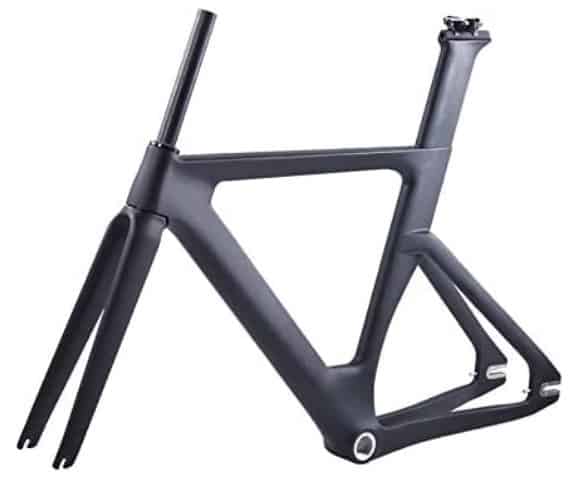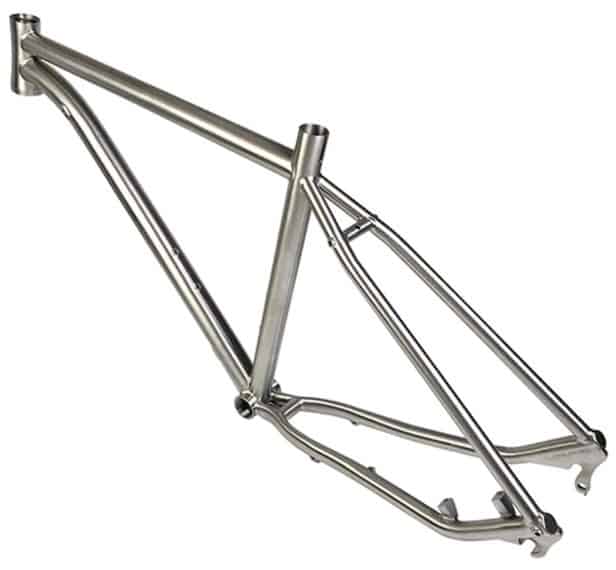The frame is one bike component that we cyclists are never prepared to repair or replace. We all want a frame that outlives our cycling years. But how long do bike frames last?
Bicycle frames can last up to 20-40 years with good maintenance. Experts, however, recommend replacing them after 5-15 years, depending on the frame material, care, and usage.
For example, it’s advisable to replace aluminum and steel after 5-10 years and 6-10 years of usage, respectively. But once it comes to carbon and titanium, you should do it after 5-7 years and 10-15 years, respectively.
Like I mentioned, the frame material primarily determines the frame’s lifespan. We’ll, however, look at other influences such as impact, stress, weather, and poor maintenance.

How Long Do Bike Frames Last?
As I mentioned, the frame type hugely determines the frame’s lifespan. Here are the average lifespans of different frame materials.
| Frame Material | Average Lifespan |
| Aluminum | 5-10 years |
| Steel | 6-10 years |
| Carbon | 5-7 years |
| Titanium | 10-15 years |
Note that I’ve offered a range for each frame material because several other factors come into play. Among them is maintenance.
Expect a frame that you care for to last longer. And when speaking of frame care, I’m talking about cleaning and polishing it and, of course, avoiding sun degradation (in the case of carbon) and rust (in the case of steel).
Additionally, not stressing the frame either by forcefully clamping it or attaching too much weight can help.
Now let’s talk about the individual frame materials:
1. How Long Does An Aluminum Frame Bike Last?
Aluminum is irrefutably the most popular frame material today. Understandably, it’s due to its lighter weight (though not as light as carbon) and affordability.
Aluminum has a strength-to-weight ratio of 274mpa, which is lower than that of the other frame materials. As a result, it’s brittle and enjoys a shorter lifespan.
Depending on the build quality, the nature of usage, and the environmental effect, aluminum bike frames last 5-10 years.
Overall, aluminum enjoys such a lifespan because of these reasons:
- Aluminum is stiffer – With a proper geometry, aluminum gives you great climbing power and better control in tighter conditions, owing to its stiffness.
- Aluminum doesn’t rust easily – Let me start by saying that aluminum can rust if exposed to moisture. The difference is that the rust layer (aluminum oxide) protects the frame from further rusting. You can, however, prevent the rust from forming using anodized paint like Dupli-Color MC 201.

Other Pros
It’s worth noting that aluminum has other impressive qualities that are not related to its lifespan.
For example, aluminum is considerably lighter than steel and even titanium. As a result, it’s pretty comfortable to ride.
Cost-wise, aluminum is cheaper than the other materials, thus more affordable.
Aluminum is also energy-efficient, and that’s because it’s lightweight, meaning you don’t use a lot of energy pedaling.
Moreover, aluminum is moldable into aerodynamic shapes for fast racing.
The Downsides
For starters, aluminum is brittle. Its low yield strength makes it weaker when under stress.
Aluminum also doesn’t dampen vibrations as much as the other materials. So, it doesn’t suit pro riders, especially those who ride off-road for long hours.
And when aluminum breaks, it’s never easy to repair. It requires expert input.
Suitability
The fact that aluminum is lighter and affordable means it’s best for recreational cyclists and commuters on a budget.
A road bike like the Schwinn Phocus 1600 (View on Amazon) exemplifies that. You can ride it for recreational and commuting reasons on-road.
2. How Long Does A Steel Bike Frame Last?
Steel is also another popular frame material. Its biggest selling point is its strength-to-weight ratio.
Steel exists in two options; carbon steel and Chromoly steel.
Carbon steel (high-tensile steel) is more robust and durable but heavier. If you want a lighter steel bike, go for Chromoly steel. In addition to being lighter and stronger, it’s also more responsive.
Unlike aluminum, steel has a much higher strength-to-weight ratio. Low-grade steel typically has a strength-to-weight ratio of 434mpa, while stainless steel’s strength-to-weight ratio is 505mpa.
Overall, steel’s higher yield strength (strength-to-weight ratio) enables it to take on much steeper terrains. Sadly, it’s prone to rust, which shortens its lifespan to about 6-10 years.
It, however, doesn’t mean that steel cannot outlive its users. It’s very much possible for steel, especially stainless steel, to last 20-40 years with proper care and usage.
Overall, steel enjoys such a lifespan because of these reasons:
- Steel is super-strong – Steel relishes a higher strength-to-weight ratio that enables it to tolerate huge weights and serve you longer.
- Steel dampens vibrations – Steel enjoys vertical flexibility, enabling it to neutralize vibrations and cushion your ride. As a result, the frame promises a more comfortable ride.
- Steel is impact-resistant – Steel can take on hard hits and aggressive use, thanks to its high yield strength. In consequence, it enjoys a longer life.
- Steel is fatigue-resistant – Due to its strength-to-weight ratio, steel doesn’t fatigue easily

Other Pros
Like aluminum, steel also has some fantastic qualities that are unrelated to its lifespan.
For one, steel is generally easier to repair as it’s weld-able. Its welding capability also means it’s more customizable.
Also, steel is super-strong; it won’t break or bend easily, which means it’s safer.
The Downside
The biggest challenge with steel is that it rusts when it comes into contact with water. And when that happens, the material weakens and wears out.
However, the rust is preventable with a rust inhibitor coat like the Rust-Oleum 7797502.
Also, avoid salty and humid conditions to prevent rust.
Plus, steel is heavier and hence slower. Furthermore, the material is slightly costlier than aluminum.
Suitability
Steel is more customizable than aluminum, and that makes it perfect for custom bikes. Its yield strength and fatigue resistance make it ideal for off-road use, as it’s the case with the Huffy Hardtail Mountain Bike (View on Amazon).
4. How Long Does A Carbon Frame Bike Last?
Carbon is one frame material that’s known for high-end bikes. Primarily, that’s due to its impressive strength-to-weight ratio.
Overall, carbon has the highest strength-to-weight ratio, which is about 3,500mpa. Its higher yield strength means it won’t break easily, even though it’s super lightweight.
But even though carbon has higher tensile strength, it’s not impact-resistant. For that reason, experts recommend replacing it after 5-7 years as it gets brittle over time after heavy use.
Overall, carbon enjoys such a lifespan because of these reasons:
- Carbon doesn’t rust – Carbon frames don’t corrode, even after contact with moisture. So it’s likely to last longer.
- Good strength-to-weight ratio – Carbon bikes enjoy the highest strength-to-weight ratio, which means they can tackle steeper gradients more comfortably.
- Carbon dampens vibrations –Thanks to its impressive tensile strength, carbon absorbs vibrations. It also swallows up the bumps to offer you a smoother ride. That explains why it’s a fantastic choice for road racing.
- Carbon is more fatigue-resistant – Compared to aluminum, carbon is stronger and therefore resists fatigue more. That also seconds why it’s suitable for racing. But still, it also explains why it’s ideal for long trips.

Other Pros
Like the other two frame materials, carbon has some impressive qualities that don’t relate to its lifespan.
For instance, since carbon is lightweight, it makes a faster bike. Carbon is also elegant, thus the best for those who like a more modern bike style.
The Downside
Carbon degrades with sunlight. The resin part of the frame, which is the bond that holds carbon together, degrades with prolonged sun exposure.
That’s unless the material comes with anti-UV stabilizers. If not, consider using anti-UV spray such as the Krylon KO1305.
The other downside is that carbon is not impact-resistant. Though carbon is strong, it’s not strong enough to resist scratching and denting.
The material fractures due to aggressive cycling, and that lowers its lifespan.
The biggest downside of carbon, however, is that it’s expensive than others.
You may have to spend $2,000 or more on a carbon frame alone. So, if you factor in the other components, you may pay up to $3,500 or more.
Suitability
I mention carbon’s vibration dampening capabilities that make it perfect for road racing. But still, its impressive fatigue resistance makes it best for long-distance touring.
An adventure road bike like the Diamondback Bicycles Haanjo 6c proves that, given that you can use it as a regular road racer or a touring bike.
5. How Long Will A Titanium Bike Frame Last?
Titanium may not be as popular as the other three frame materials but is amongst the most robust and most reliable options.
Titanium has an elegant appeal and is powerfully agile. Its agility makes it ideal for competitive cycling, while its elegance makes it a timeless option.
In terms of strength-to-weight ratio, titanium is quite impressive. Titanium has the same yield strength as low-grade steel (that is 434mpa).
Its yield strength is quite remarkable, which means it can take on heavy usage.
Titanium is generally impact-resistant, fatigue-resistant, and rust-resistant, enabling it to last 20-40 years. Experts, however, recommend replacing it after 10-15 years.
Overall, titanium enjoys an impressive lifespan because of these reasons:
- Titanium is fatigue-resistant – Titanium’s strength-to-weight ratio is outstanding. It offers it inherent flexibility that enables it to overcome fatigue. So, titanium can tolerate physical strength without degrading, thus long-lasting.
- Titanium is rust-resistant – Titanium doesn’t rust. It forms a natural protective coating (titanium dioxide) that prevents oxidation while giving it a natural look.
- Titanium has good vibration-dampening properties – Titanium is adequately strong to soak up vibrations, just like carbon. As a result, the frame feels much comfortable, especially on long rides.
- Titanium is stiffer – Since the strength-to-weight ratio is remarkable, titanium is rigid/stiff. Its stiffness promise efficient power transfer and ease of pedaling without sacrificing the frame’s structural integrity.
- Titanium is impact-resistant – Again, titanium’s impressive strength-to-weight ratio enables it to take on the hardest hits. It can soak up more impact than other frame materials.
- Titanium resists extreme weather and is therefore likely to rust longer in different weather conditions

The Downside
Despite its impact resistance, titanium can rust. Conditions like heated chlorides and the welding gas argon can make titanium crack over time, especially following prolonged contact.
Titanium is also considerably costlier than aluminum and steel. In addition, it’s heavier, and that makes it slower.
Suitability
Titanium’s customization capability and flexibility make it suitable for custom bikes. Hence, it’s a chief target for professional riders.
But still, if you want a high-end bike to ride for decades, titanium is the way to go.
One fantastic choice worth checking out on Amazon is the SEADOSHOPPING BMX Bike Frame. It’s not just perfect for BMX but can also be modified to suit mountain bikes, cruisers, road bicycles, and kids’ bikes.
Factors that Affects the Lifespan of Bike Frames
The average lifespan of the four bike frame materials hugely depends on these four factors:
a. Impact
What gives materials like steel and titanium a much longer lifespan is their ability to take on brutal punishment. Simply put, they are more impact-resistant.
If you expose carbon or aluminum to take on the same punishment, the chances are that they’ll snap out.
b. Stress
Putting too much pressure or adding too much load on a bike frame only stresses it. Consequently, its yield strength weakens. So it’s likely to twist, bend, or break.
That’s often the case with carbon and aluminum. So, their shorter lifespan is because they weaken under stress.
c. Poor Maintenance
The care that you give the frame also has a massive impact on its lifespan.
Cleaning the bike frame with soap and water or an effective frame cleaner such as the Finish Line Super Bike Wash boosts its life.
It also helps to wax the frame regularly as you maintain its radiance.
d. Weather
The biggest threat to the lifespan of bicycle frames, in general, is bad weather. Steel, for example, rust due to prolonged exposure to humid conditions, while carbon degrades due to prolonged sun exposure.
So, generally, protecting the frame against bad weather is a crucial step to boosting its lifespan.

FAQs
1. Do Bike Frames Wear Out?
Bike frames wear out eventually, mainly due to heavy abuse and poor maintenance. But if you clean and protect the frame from poor weather, a quality frame could outlive your cycling years.
2. Are Aluminum Bike Frames Durable?
The biggest strength of aluminum is its corrosion resistance. It also enjoys a much stiffer dimension, which makes it reasonably durable. It, however, gets brittle following heavy abuse, and that hampers its durability.
3. Do Aluminum Bike Frames Fatigue?
Though aluminum is stiff, its tensile strength reduces following heavy use. So, aluminum is not fatigue-resistant, and that means it’s not the best for aggressive cycling, mainly off-road.
4. Can Carbon Bike Frames Be Repaired?
Carbon is repairable. It’s only that the repair is a little more challenging as carbon is brittle. But if you take the frame to expert fabricators, they’ll know what to do to fix it.
5. Do Carbon Bike Frames Fatigue?
Carbon bike frames don’t fatigue easily, but that doesn’t make them 100% fatigue resistant. But unlike an option like aluminum, carbon can take on regular usage as long as you don’t overload or scratch it.
6. Are Aluminum Bike Frames Good?
Aluminum bike frames are the most affordable bike frames on the market (alongside steel). They are also relatively lightweight, making them comfortable on a variety of terrains.
Their downside is that they are brittle and aren’t fatigue-resistant, which means they have a shorter lifespan.
7. Are Steel Bike Frames Good?
Steel bike frames may be heavier or even slower, but they have some impressive qualities. They are more fatigue-resistant and impact-resistant, thus more durable.
Steel also dampens vibrations to offer you a smoother and more comfortable ride. You have to find a way to protect the frame from rust to enjoy its optimum performance.
8. Is A Carbon Bike Frame Lighter Than Aluminum?
A carbon bike is faster than an aluminum bike of the same size and design. That’s because carbon is less dense and therefore more lightweight than aluminum.
Note, however, that the aerodynamics of the bikes have a role to play and not just the material lightweight.
9. Are Carbon Bike Frames Worth It?
Carbon bike frames may be costlier than most, but they are worth it because of their lighter weight and fatigue resistance. They also dampen vibrations, thus more comfortable and rust-resistant.
10. Do Steel Bike Frames Wear Out?
Every bike frame wears out in due time, and steel is no exception. The difference is that steel has higher tensile strength and impact resistance, and, as a result, it can outlast most frames.
Steel, however, rust if unprotected, and rust considerably shortens its lifespan.
11. Do Titanium Bike Frames Break?
Titanium bike frames have impressive tensile strength, impact resistance, and fatigue resistance. So, they won’t break easily, especially from normal usage.
Closing Thought: How Long Do Bike Frames Last?
Now that you know that a bike frame can last 5-15 years, you can choose one depending on the frame type that interests you the most.
Remember to consider your cycling needs, nevertheless. As seen, all these frame materials have their suitability, which is critical to making a purchase.